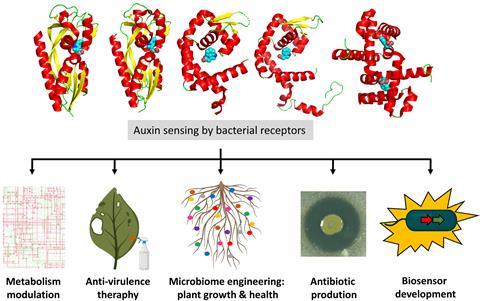Scientists have discovered a bacterium carrying a receptor protein that allows it to migrate towards auxins in its plant host, which act as bacterial signalling molecules.
The team at the Spanish Research Council in Granada have had their invited opinion piece, ‘The emerging role of auxins as bacterial signal molecules: potential biotechnological applications’ accepted for Microbial Biotechnology, an Applied Microbiology International publication.

The Estación Experimental del Zaidín lab led by Dr Miguel A. Matilla in Granada (Spanish National Research Council), focuses on the study, using multidisciplinary approaches, of the mechanisms by which plant-associated bacteria respond and adapt to different environmental stimuli. These stimuli include the perception of different chemical signals that allow them to adapt their physiology and metabolism to the interaction with plant hosts.
“Auxins are key phytohormones for plant growth and development, as well as for defence against pathogens. We have found that the specific sensing of these molecules by different bacterial receptor proteins allows beneficial bacteria to modulate their chemotactic movement, possibly to facilitate plant colonisation, as well as to regulate antibiotic production in a plant disease biocontrol bacterial agent,” Dr Matilla says.
Environmental signals
“Bacteria are subjected to a multitude of environmental stimuli and chemical signals. However, the mechanisms, such as receptor proteins, that recognise most of these signals or, alternatively, the signals that are recognised by proteins that are key to fundamental bacterial processes are mostly unknown.
“The identification of these chemical signals is of special relevance for understanding how bacteria regulate their metabolism and physiology. By advancing this knowledge, we can progress in the development of biotechnological, environmental and clinical approaches based on bacteria or bacterial signalling processes.
“Based on this gap in knowledge, our research aims to advance in this direction through the identification of the mechanisms of recognition and response of bacteria to key signalling molecules such as auxins – fundamental molecules for plants, but also in communication between plants and their associated microorganisms.”
The team used a plant phyllosphere isolate of the bacterium Pseudomonas putida to demonstrate that a bacterium is able to migrate chemotactically towards the auxin phytohormone indole-3-acetic acid. They then identified the receptor protein responsible for this process, called PcpI (Pseudomonas chemotaxis protein indole-3-acetic acid) and demonstrated that this chemoreceptor is also involved in the chemotactic response of P. putida to another phytohormone, salicylic acid.
“To our knowledge, PcpI is the first chemoreceptor that responds to two different plant hormones,” Dr Matilla says.
Rhizosphere bacteria
“Our research has also allowed us to advance in the mechanisms of antibiotic regulation by auxins by using as model bacteria an isolate from plant roots (rhizosphere) of the species Serratia plymuthica. This bacterial isolate produces several antibiotics that are active against different plant pathogens.
“We found that the sensor protein AdmX, involved in antibiotic regulation in S. plymuthica, specifically recognises the auxins indole-3-acetic acid and indole-3-pyruvic acid. Although both auxins are structurally very similar, only the recognition of indole-3-acetic acid results in altered antibiotic production in Serratia plymuthica - suggesting that these two auxins act as agonists and antagonists through their binding to AdmX”.
“To advance this knowledge, we have solved the three-dimensional structure of the AdmX sensor domain in the presence of both auxins, and characterised the molecular recognition of auxins by AdmX using different complementary experimental approaches”.
“Our results show that there are different conformational and compaction changes in AdmX in the presence of indole-3-acetic acid and indole-3-pyruvic acid. These results allowed us to advance in the mechanisms by which auxins can function as agonists and antagonists. Notably, we have defined a protein motif responsible for auxin recognition; a strategy that has also allowed us to suggest that AdmX (and related proteins) have co-evolved during plant-bacteria interaction to sense auxins.”
Beneficial bacteria
Because the model microorganisms used to examine the mechanism of recognition of signalling molecules are beneficial bacteria that act as disease biocontrol agents, the next steps may be to focus on using this knowledge to improve plant colonisation in this and other plant growth-promoting bacteria, engineering plant microbiomes and identifying new antibiotics. These results could also be applied to other model microorganisms of interest to the scientific community.
“Auxins are key signal molecules in the plant-bacteria interaction and understanding how these organisms communicate, as well as the responses that arise from this communication, are fundamental in the current context of climate change and the need to improve the productive yields of our crops at a global level,” Dr. Matilla says.
“In this sense, the plant microbiome is key to plant health. Deciphering the chemical communication that exists between plants and their associated microorganisms will allow us to advance in developing biotechnological approaches for altering plant microbiomes à la carte.
“Our research has made progress in this regard and future work will allow further insights into this inter-kingdom communication that is key to plant health and agricultural productivity.”
These studies have been led by Dr. Miguel A. Matilla (Estación Experimental del Zaidín – Spanish Research Council; Granada, Spain) in collaboration with international researchers from Spain (Prof. Tino Krell of Spanish Research Council; Dr. José A. Gavira and Dr. Amalia Roca of University of Granada; Dr. Alvaro Ortega of University of Murcia) the United States (Prof. Igor B. Zhulin of University of Ohio), and Russia (Dr. Natalia V. Petukhova and Dr. Dmitrii S. Bug of Saint Petersburg Medical State University).
The research has been supported through grants from the CSIC, the Spanish Ministry for Science and Innovation/Agencia Estatal de Investigacion, the Junta de Andalucía, NIH Grant and the Ramon y Cajal R&D&i Programme from the Spanish Ministry for Science and Innovation.
‘The emerging role of auxins as bacterial signal molecules: potential biotechnological applications’ appears in Microbial Biotechnology.







No comments yet